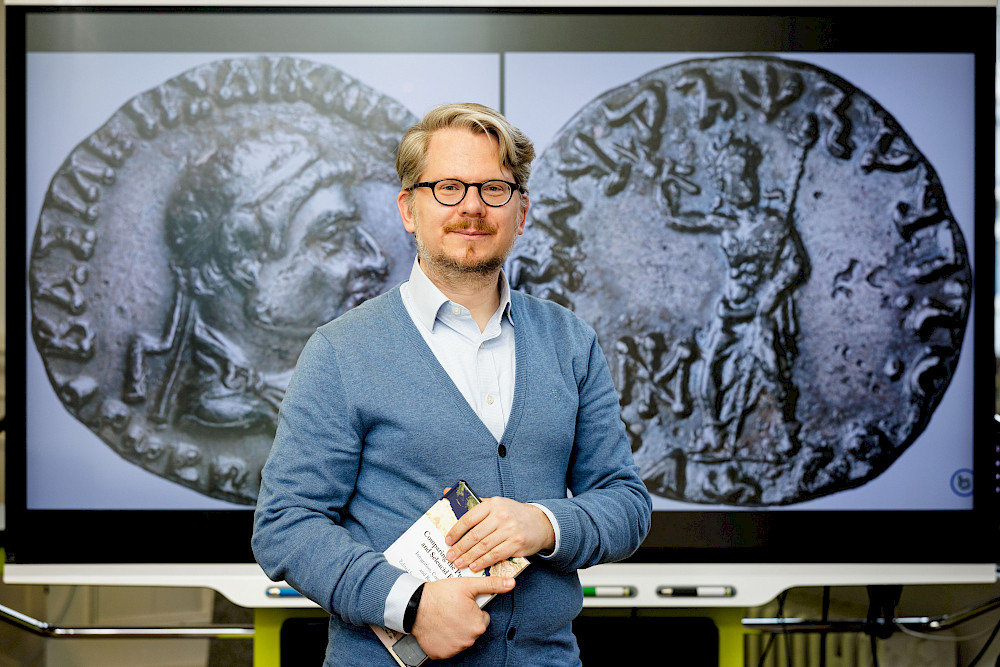The secrets of ancient coins

The age of Hellenism began in the 4th century BC with Alexander the Great as the general extended his domains all the way to the Indian subcontinent. “Alexander’s conquests included the areas north and south of the Hindu Kush, which today lie in Afghanistan, Turkmenistan, Uzbekistan, Tajikistan, Pakistan and India,” explains Gunnar Dumke, research associate at the Chair of Ancient History at MLU. “There he established Greek mercenaries in the north. These Graeco-Bactrians became independent and installed their own kings.” At some point, however, they were themselves harassed by nomadic peoples and moved south across the Hindu Kush to India. “Today we call these rulers Indo-Greeks.” By the turn of the century, their trail was lost.
“In fact, we know very little about them because the region was too remote from the Greek centres of power for any news from there to have sparked much interest,” says Dumke. “Classical sources tell us very little or are only fragmentary.” Unlike in Greece, only a handful of systematic excavations have been conducted in this region. Nevertheless, some significant finds do allow conclusions to be drawn: coins that the rulers minted and circulated during their time in power. “The names of eight Graeco-Bactrian and Indo-Greek rulers are known from the literature. However, when we count the coins on which different rulers are depicted, we find over 40. That is quite a difference.”
Gunnar Dumke located 4,500 coins from the Indo-Greek period in museums, public and private collections and auction catalogues from around the world and has examined them for his dissertation. He concentrated on the coins of 20 rulers who travelled south of the Hindu Kush around 150 to 60 BC. What they all have in common is that the ruler who issued the series of coins is depicted on the front of the coin, known as the obverse. “This practice was introduced by Alexander the Great and was common throughout the Mediterranean region,” says Dumke. Deities are depicted on the back - or the reverse - of the coin. The fact that the 20 rulers often pose in military armour suggests that the coins were minted mainly as pay for military campaigns – evidence that warlike events may have played a central role in this period. “This would also explain why we find 20 rulers in such a short space of time. They may have warred with each other,” Dumke surmises. “Or they may have divided up the territories in a way that we have yet to understand.” The few Indian sources that we do have also make it clear that there was warfare, says the researcher.
In order to learn more about the number and distribution of the coins, Dumke used the numismatic method of stamp coupling. This involves comparing the obverse and reverse sides of coins down to the tiniest of details. To mint the coins, stamps for the front and back were made by hand. The stamps for the reverse side wore out more quickly during the stamping process and had to be replaced more often - a circumstance that has benefited science. This is because the different combinations of the obverse and reverse sides of a coin within a series can provide information about the minting series. Researchers can also calculate the number of stamps used. This is an indicator of the total number of a ruler’s coins and thus his financial position.
Something that cannot be reconstructed, however, is how the coins were used as a means of payment, Dumke notes. “Most of the silver coins in the study were too valuable to have been of any use when shopping for day-to-day items,” he says. It is interesting to note that the rulers south of the Hindu Kush reduced the weight of the coins to be more in line with Indian standards. “This may be due to the lack of silver material - or because the rulers wanted to ensure that their coins were accepted and could be exchanged for Indian money,” says the researcher. Inscriptions were now written in two languages - and the depictions were also adapted more for India. “Some of the Greek rulers are symbolically depicted with elephants, and flames are placed on the shoulders of one depiction of Zeus, lending him the appearance of the Indian fire god Agni.” It is doubtful that these attempts at cultural assimilation were well received, says Dumke. “As foreign rulers, the Greeks do not come over so well in the Indian sources.”
One major problem that Dumke sees is the exact origin and traceability of the coins he examines. Half of them come from trade. This means that there is always the possibility that some have been looted. Excluding such material from the study is ethically understandable, but not advisable for content-related reasons: “As soon as archaeological finds are published in scientific journals, it becomes more difficult to sell them on again.” The international Oxus-Indus project of the American Numismatic Society, led by Oxford University, is also heading in this direction. Gunnar Dumke is involved in this project. The aim is to create the first database of the thousands of Graeco-Bactrian and Indo-Greek coins found in collections around the world so that they can be utilised for science. This could also help local authorities who are dealing with art theft. “There is a room in the museum in Peshawar, Pakistan where confiscated finds are stored,” says Dumke. There, entire hoards are kept in rubbish bags and the staff cannot count the coins fast enough. “We are hoping that our research will provide them with some long-term assistance that will enable the coins to be identified more quickly in the future. We want to help preserve their cultural treasure and history.”
Gunnar Dumke
Institute for Ancient Studies
Telephone +49 345 55-24013
Mail gunnar.dumke@altertum.unihalle.de
